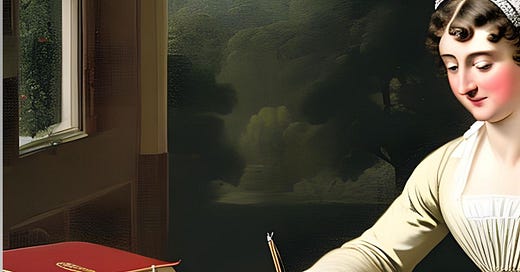Epistolary Time Travel 200 Years: Jane Austen's Legacy in Letters
This 18th-century novelist (1775-1817) was a prolific note and letter writer
I love diving into the letters of literary giants to glean both nostalgic comfort and invaluable insight into their world and their craft. Jane Austen stands tall among my epistolary heroines. Her letters serve as an extension of her narrative mastery and an intimate lens into her personal life. Sadly, not all survive. Some were thrown out from carelessness. Others are thought to have been destroyed because they contained details or criticism of friends or family members too intimate to share (LeFaye).
The Letters to Cassandra
Much of what we know about Jane Austen's correspondence life is from her epistles to her sister, Cassandra. These messages serve as a rich tapestry, stitched with the mundane details of late 18th-century life, sibling banter, considerable gossip, and the burden of societal norms. They also reveal Austen's personal writing journey, including hopes for her own work and frustrations with the publishing process of the time (LeFaye).
In the Preface to the Fourth Edition of Jane Austen’s Letters, editor Deidre LeFaye says, “The letters to Cassandra are the equivalent of telephone calls between the sisters—hasty and elliptical, keeping each other informed of domestic events and occasionally making comments on the news of the day, both local and national.” She went on to describe Austen’s correspondence with her brother, away at sea, as a “more regular and considered style,” and the collection includes “cheerfully teasing letters” to a young cousin.
Austen’s Morning Rituals and Writing Spaces
According to family lore and her surviving letters, Jane often did her writing in the mornings. She wrote on small pieces of paper, usually at a modest table in her family's living room. Like most writers, she snatched moments of solitary concentration from her life of domestic activity.
Her Wit and Observations
Austen's letters are filled with her signature wit, observations on human folly, and keen insights into social customs. In her letters, we frequently find a more immediate and personal voice, revealing fears, hopes, annoyances, and joys that are sometimes only hinted at in her novels (LeFaye). it’s not hard to see the seeds that bloomed into characters like Elizabeth Bennet or Emma Woodhouse.
A Window into the Regency Era
Austen's letters offer a veritable treasure trove of late 18th-century vernacular, sentence structures, and even the art of opening and closing statements in a letter.
Tuesday 23 August 1796
Cork Street Tuesday morning
My dearest CassandraThey are like time capsules, preserving the minutiae of an existence where the pace of life allowed for the luxury of contemplation and thoughtful writing. She was candid about many subjects and held strong, opinions—both delight and displeasure—on others in her social circle as well as worries about her brother’s health (Tomalin).
What are we leaving for future historians?
In a world where “snail mail” is romanticized yet practiced far too seldom, the letters of Jane Austen remind us of the deeply intimate and human art of correspondence. For me—and I hope for others among today's avid note and letter writers—they offer inspiration to put pen to paper and capture the ordinary and extraordinary moments of daily life.
Future historians will thank us for it.
---
### References
- Le Faye, Deirdre, Editor. Jane Austen's Letters. Oxford and New York. Oxford University Press, 2011 (and earlier editions).
- Tomalin, Claire. Jane Austen: A Life. New York City. Penguin Random House, 1997.
NEXT WEEK: I’ll tell you about the seven fountain pens I use regularly. Later this fall I’ll recommend some good starter fountain pens that let you experience them without breaking the bank. Be sure you’re subscribed so my posts will come right to your Inbox.
I love hearing your comments and feedback below! Please share this with someone you think will enjoy it.






Yes! We writers owe it to ourselves to carve out that special time. Thank you for that thoughtful reminder, Pamela.
Lovely few minutes reading about Jane Austen. I do love a time period where reflection and communication through letters was the norm. Carving out a time for writing is the good takeaway from your article